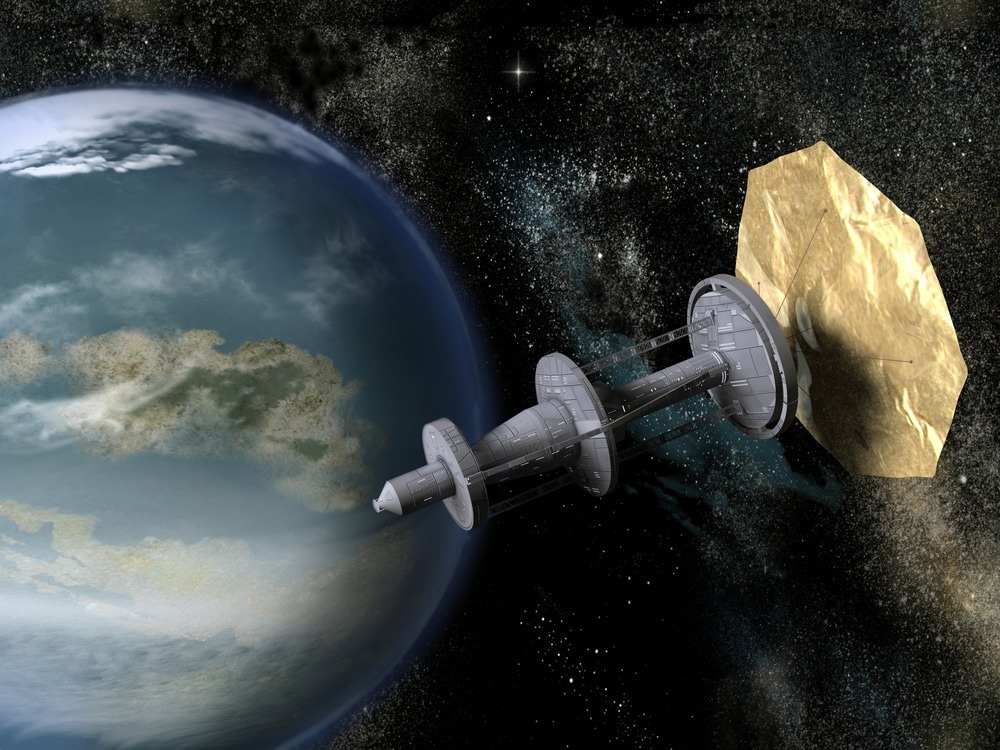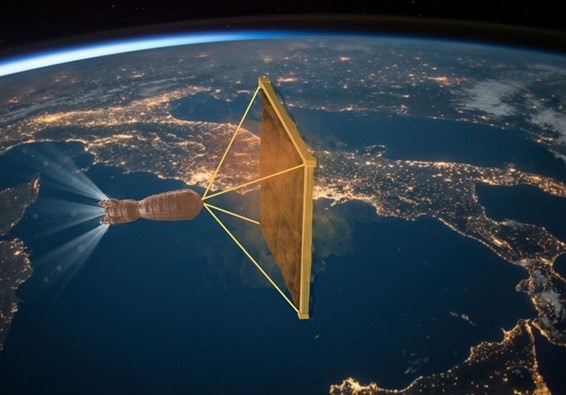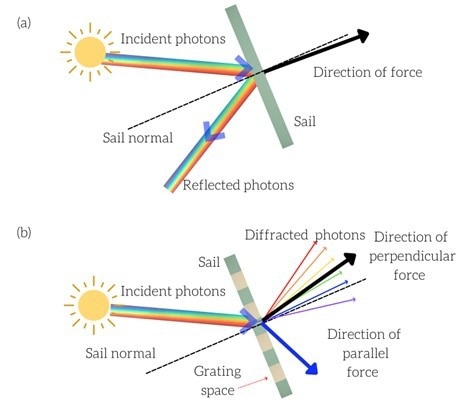A NASA-backed developmental project uses the diffractive property of light to propel solar sails.

Image Credit: Esteban De Armas/Shutterstock.com
NASA’s innovative leadership in pushing the boundaries of space exploration has accomplished many breakthroughs. NASA recently confirmed $ 2 Million in support to continue the development of a diffractive solar sail.
What are Solar Sails?
Solar sails are space exploration vehicles that operate in much the same way as sailboats, which use the wind gusts intercepted by expansive sails to navigate the boat.
In a solar sail, light pressure forces produced by sunlight are used for maneuvering. Light is delivered by particles of photons, which exert forces in meticulously constructed metal sails that allow for solar sails to propagate through space as shown in figure 1.

Figure 1: Image showing a solar sail in space. Image Credit: Ilamaran Sivarajah
NASA has supported many years of study that could exploit sunlight to propel space vehicles.
Aspirations have ranged from near-earth exploration to interplanetary and interstellar missions. To assess the viability of solar sails, many microscopically thin materials have been tested. Sizes scaling from a few meters to several kilometers have been analyzed.
Most of the sails developed for solar sails have used light reflection to impart momentum.
The materials used for the sail use a reflective metal coating to absorb the incident photons. The diffractive solar sail uses an alternative method based on light diffraction.
Technological improvements in highly efficient, broadband, single-diffraction-order gratings make it possible to investigate this different approach.
Reflective Solar Sails
Figure 2(a) depicts the working principle of a reflective solar sail. Portions of the incoming photons from the sunlight are absorbed by the thin metallic sail. Adhering to the laws of light reflection, a radiation pressure force is produced in the direction normal to the sail surface. The amount of force exerted on the sail grows proportionally with the size of the surface area. For reference, solar sails that are 10, 000 square meters in size have been constructed, which is equivalent to the area of two football fields in dimension.
The solar sail is steered by changing the angle of the sail surface with respect to the direction of the sun’s rays.
The “pitch angle” is the angle between the incident light beam and the normal line from the sail surface. The orbit of the sail can be raised or lowered by tilting the pitch angle.
Limitations of Reflective Solar Sails
There are several drawbacks to reflective solar sails. Since the metallic sheet absorbs the photons, the sail gradually heats up. The longevity of the solar sails is a concern as structural damages could occur due to the heating.
The conversion of incoming photons to the perpendicular thrust required for steering is quite low in reflective sails. A high percentage of photons impinging on the sail has minimal impact.
Furthermore, photons impinging on a reflective sail are only used once. These photons either transfer momentum to the sail or are reflected back into space.
Diffractive Solar Sails
When light waves pass through an opening or slit they spread into different wavelength components as shown in figure 2(b). This dispersive property of light is defined as diffraction. The rainbow spectrum that can be seen on shiny materials such as compact discs is due to light diffraction.

Figure 2: (a) Reflective solar sail. (b) Diffractive solar sail. Image Credit: Ilamaran Sivarajah
Solar sails can be designed using this phenomenon, which functions differently from the reflective solar sail. A sail made out of diffraction gratings, which are commonly used in many optical technologies, replaces the metallic reflecting material.
Light diffraction theory is described by the grating equation which relates the angle of diffraction to the ratio of the wavelength and the spacing of the grating.
Unlike reflective sails, diffraction grating-based solar sails produce radiation-pressure force in both the perpendicular and parallel directions (figure 2(b)).
Technological advancements in grating design and function have made them more efficient and offer more control.
One such advantage is the ability to electrically control the spacing of the grating. This allows them to steer the sail without having to tilt the sail surface.
Since diffraction grating transmits photons through the spacing, the material itself absorbs very little light. Consequently, heating effects usually encountered in reflective sails are largely mitigated when using diffraction sails.
Photons arriving at a diffraction sail can also be reused. While a high percentage of a photon's momentum is transferred to light pressure force, the rest of the light can be converted into electricity via solar cells.
Secondary photons can also be redirected through a second grating to create more radiation pressure. Other apparatus installed in the solar sail to capture useful research data in space can be powered by the electricity produced in the solar cell.
The Future of Diffraction Solar Sails
While the development of diffraction solar sails is still in its early days, there is worldwide interest in the progress.
Aside from NASA, commercial and academic organizations are getting involved with the design and implementation strategies.
Short and long-term roadmaps have been outlined and multidisciplinary communities are collaborating.
References and Further Reading
Amber L. Dubill, Grover A. Swartzlander, Circumnavigating the sun with diffractive solar sails, Acta Astronautica, Volume 187, 2021, Pages 190-195, ISSN 0094-5765, https://doi.org/10.1016/j.actaastro.2021.06.036.
Swartzlander, G. (2017) Space and Astronomy: Diffractive solar sails could outperform reflective-metal-coated sails. [Online] laserfocusworld.com. Available at: https://www.laserfocusworld.com/optics/article/16548235/space-and-astronomy-diffractive-solar-sails-could-outperform-reflectivemetalcoated-sails
Optics.org. (2022) NASA backs diffractive solar sails. [Online] Optics.org. Available at: https://optics.org/news/13/6/1
Disclaimer: The views expressed here are those of the author expressed in their private capacity and do not necessarily represent the views of AZoM.com Limited T/A AZoNetwork the owner and operator of this website. This disclaimer forms part of the Terms and conditions of use of this website.